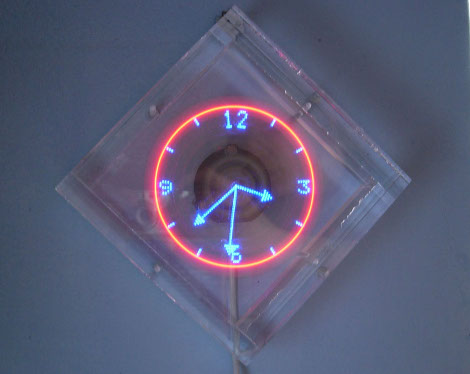
This gorgeous persistence of vision clock was built a couple years back by [mb1988]. The housing is made of acrylic with a hard drive motor mounted in the center of the back panel to spin a PCB. The two-sided circuit board is home-made and includes a battery for power, ATmega32 for the brain, 32 LEDs, four display drivers, and a real time clock module. The spinning hard drive motor is nearly silent and already has threaded mounting holes on it. [mb1988] uses an optoelectric sensor to sync the display with the rate of rotation. The forum post includes download for the code and hardware details. Don’t miss the demonstration after the break.
[youtube=http://www.youtube.com/watch?v=no2_M_b059g]
[Thanks Tehgringe]














Is that the terminator music ?
On a side note has been done before but not that well imho.Job well done :D
Very nice! Excellent look
I wish I knew about this TDA5140A when I was making Strobeshnik. Good find for the future reference.
How beautiful! To make it even more spectacular he could add some waving effects using sine functions over the plot routines: POV Dali clock FTW!:)
@dmcbeing: It’s “Pass Portal” by Team Sleep. (It had been on The Matrix Reloaded soundtracks.)
@dmcbeing: “Pass Portal” by Team Sleep. (It has been on The Matrix Reloaded soundtracks.)
dmcbeing: No. This is:
http://www.youtube.com/watch?v=QKF-tOtK6nw
Or T2 if you prefer that:
http://www.youtube.com/watch?v=uXQTzJgU6qc&feature=related
Still gives me goosebumps, such great movies :)
And what a gorgeous piece of PCB design too!
i wish i had a giant one on my ceiling. it looks awesome.
He doesn’t use a battery, there is a track on the bottom side that he uses with a contact to make a slip ring. I’m guessing that ground is done through the screws into the motor.
This is definitely one of the best POV clocks I’ve seen so far.
Neat!
OK the clock modes are all very nice looking but the rotating Necker cube is just showing off.
That is fantastic. Love the different modes, and the vector graphic is amazing.
Wow, the mechanical balance of that pcb is obviously perfect. That makes me wonder about the effect that spinning would have on the components over time. If they moved the balance could change resulting in disaster. Not to be a downer. Too nice to look at. What RPM is it running at I wonder.
That is really sweet, I’ed like to see it in black acrylic though and now they’ll know what time it is on the Borg Cube. :)
The cube animation did it for me.
The screws ruined it for me.
great clock, gotta love POV projects.
The song is from The Matrix Reloaded:
Whoops – hit submit prematurely…
Song is:
Team Sleep – The Passportal from Matrix Reloaded.
I love POV devices, but I could never have one in my house. I’ve never come across one that didn’t produce a lot of noise. Sure, during the day it may not sound loud, but at night when you are tying to sleep they are just too loud.
looks great.
Yo dawg, we heard you like cubes so we put a cube inside your cube so you can feel symmetric while you’re feeling symmetric.
I built a regular HDD POV clock, but the mainboard crapped out and quit driving the motor. For lack of appropriate parts and motivation, I just shelved it until I could get some kind of easy to use motor driver.
I was hoping that the TDA5140A that he used could revive it, but alas, it looks like it’s not manufactured anymore. Anyone know of an alternative all-in-one solution for driving a BLDC motor? I know I can do it with an MCU and some discrete components, but this chip is just so perfect for this sort of application.
Yo dawg Thx fo the cube inside uh cube.
i want to make this pov clock
can anybody give me ckt diagram and mechanical
hardware arrangment